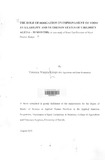| dc.description.abstract | Over dependence on rain-fed agriculture is one of the major problems in Kenya's
agricultural sector. Irrigation, use of fertiliser and improved crop varieties have
been identified as the key inputs for increasing crop yields. Given that about 80
percent of the country's land surface falls under arid and semi-arid areas and
majority of the population living in rural areas depend on agriculture for their
livelihood, irrigation is inevitable. However, what is not clear is the role of
irrigation water on household food security and nutritional status per se. This
study investigated the role of irrigation on improvement of household food
security and nutritional status. The study was conducted in Kieni East division of
Nyeri district; an area of high agricultural potential but aridity hinders its
exploitation. The Nyeri Dry Area Smallholder Community Services Development
Project has been involved in provision of irrigation water in the study area with the
aim of raising food production and improving the nutritional status of the target
population.
Two random sub-samples that consisted of 59 households each were selected.
They comprised of project households (those with access to irrigation water) and
non-project households (those without access to irrigation water). Agricultural
production data was based on production figures of the year 2000, while the 24-
hour dietary recall determined dietary energy and nutrient intake. Food security
was assessed in terms of household dietary energy adequacy ratio and proportion
of income spent on food. Households whose energy adequacy ratio was below 0.8
or who spent more than 60 percent of income on food were considered food
insecure. Anthropometric measurements were used to assess the nutritional status
of children aged 6 - 59 months.
Provision of irrigation water increased crop yields such that the average maize
yield in the project households (141.1kg/acre) was 3.2 times more than that of
non-project, which was 44.2kg/acre; the difference was significant. It can be
concluded that irrigation has led to a shift from subsistence to commercial farming
since significantly more project households than non-project households engaged
in commercial farming. Commercial farming was found to have a positive effect
on income levels. The number of non-commercial farming households below the
rural poverty line (KSh. 1240) was three times significantly more that of
commercial farming households. However, improvement of income In
commercial farming does not appear to have a significant influence on household
food security.
Although the prevalence of underweight and stunting in the project households
(3% and 10% respectively) was lower than in non-project households, which was
10% and 17%, there was no significant difference. This implies that provision of
water in Kieni East division has not lead to a significant improvement of
nutritional status of young children. However, since children from the project
households were better off, it can be concluded that irrigation has contributed to
protection of nutritional status. There is need for further research because the
impact of irrigation could have been misrepresented, since the reference period
was characterised by drought, which subsequently affected availability of water. | en |

